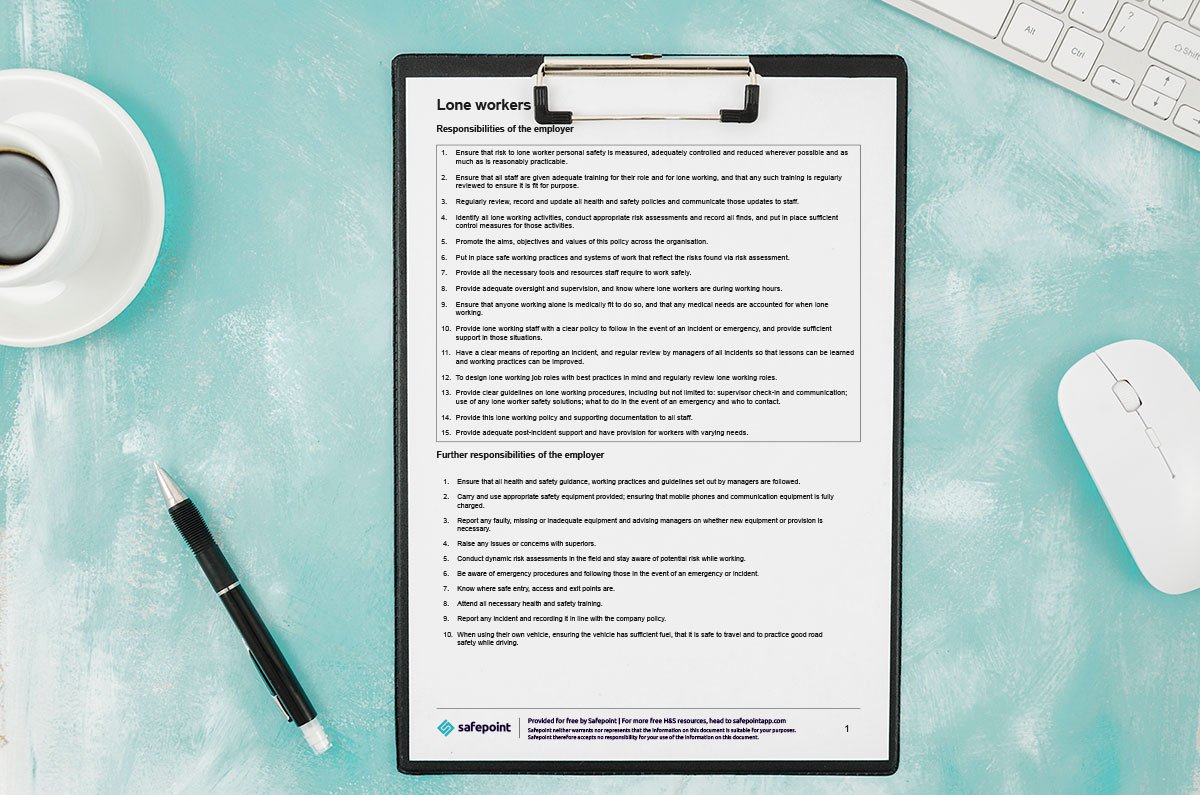FREE lone working policy template
What is a lone working policy?
A lone working policy is a document that sets out your company’s rules, best practices and guidance for working alone. It will help new and existing staff understand the risks to them and their organisation when lone working.
Broadly, your lone-working policy will include findings from your risk assessments, industry best practices, practical guidance, legal obligations and other items that allow both lone working employees and employers to understand their responsibilities, work safely and legally, and know what to do in the event of an incident.
It’s a legal requirement to conduct risk assessments for your staff, including their lone working practices.
If they have been meaningfully and practically put together, your risk assessment and lone working policies can be key factors in reducing incidents involving lone workers.
Claim your free lone working policy template
We have put together a free lone working policy template to help you keep your team safe when they’re working alone.
As well as providing common policy ideas for you to consider, we give you an easy format to build and expand your policy.
What to include in a lone worker policy
Here are some examples of what to include in a lone worker policy:
Responsibilities of an employer
Ensure that risk to lone worker personal safety is measured, adequately controlled and reduced wherever possible and as much as is reasonably practicable.
Ensure that all staff are given adequate training for their role and for lone working, and that any such training is regularly reviewed to ensure it is fit for purpose.
Regularly review, record and update all health and safety policies and communicate those updates to staff.
Identify all lone working activities, conduct appropriate risk assessments and record all finds, and put in place sufficient control measures for those activities.
Promote the aims, objectives and values of this policy across the organisation.
Put in place safe working practices and systems of work that reflect the risks found via risk assessment.
Provide all the necessary tools and resources staff require to work safely (this may include lone worker solutions).
Provide adequate oversight and supervision, and know where lone workers are during working hours.
Ensure that anyone working alone is medically fit to do so, and that any medical needs are accounted for when lone working.
Provide lone working staff with a clear policy to follow in the event of an incident or emergency, and provide sufficient support in those situations.
Have a clear means of reporting an incident, and regular review by managers of all incidents so that lessons can be learned and working practices can be improved.
To design lone working job roles with best practices in mind and regularly review lone working roles.
Provide clear guidelines on lone working procedures, including but not limited to: supervisor check-in and communication; use of any lone worker safety solutions; what to do in the event of an emergency and who to contact.
Provide this lone working policy and supporting documentation to all staff.
Provide adequate post-incident support and have provision for workers with varying needs.
Responsibilities for a lone worker
Ensure that all health and safety guidance, working practices and guidelines set out by managers are followed.
Carry and use appropriate safety equipment provided; ensuring that mobile phones and communication equipment is fully charged.
Report any faulty, missing or inadequate equipment and advising managers on whether new equipment or provision is necessary.
Raise any issues or concerns with superiors.
Conduct dynamic risk assessments in the field and stay aware of potential risk while working.
Be aware of emergency procedures and following those in the event of an emergency or incident.
Know where safe entry, access and exit points are.
Attend all necessary health and safety training.
Report any incident and recording it in line with the company policy.
When using their own vehicle, ensuring the vehicle has sufficient fuel, that it is safe to travel and to practice good road safety while driving.
Ensure they are medically fit to perform tasks when lone working, to disclose any reason they are unable to perform tasks and communicate needs to a manager.
To read this lone working policy and follow the guidelines therein.
To take personal responsibility for, and provide a duty of care for themselves and colleagues.
Lone worker risk assessment
Sometimes, it may be necessary to create an separate risk assessment for lone workers. Our free lone worker policy template will help you write one. Areas you should think about include:
Does the workplace location present risk to the lone worker?
Can one person adequately control the risks of the job?
Is the person medically fit and able to work alone?
What training is needed to make sure the staff member is able to work safely alone?
What kinds of clients or service users will the lone worker be interacting with?
Is there a threat of violence or aggression?
Is there the danger of theft, forced entry?
Are all the tasks able to be performed alone?
Is there safe entry, exit and access to and from the workplace?
What methods of communication are available and are they sufficient?
What hazards are present as a result of the role, location, and as a result of lone working?
Do lone workers have the necessary equipment or machinery to carry out their work? Is that equipment operable by one person?
Can all substances and materials be safely handled and transported by a lone worker? 14. What control measures are in place to prevent risk?
How likely are specific risks to occur?
16. What are the hours of work?


